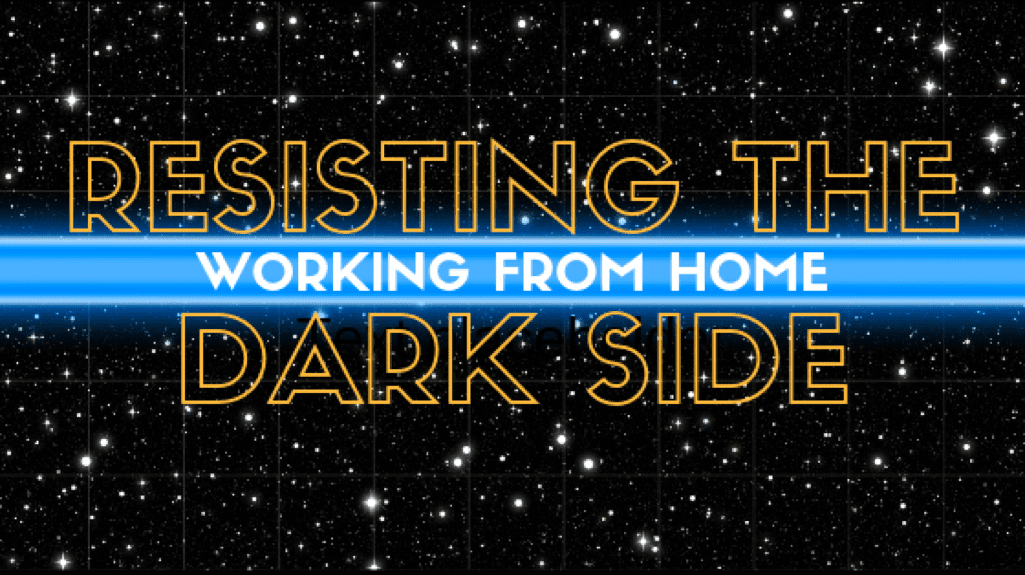10 ways to combat the dark side of working from home (when life is imploding around you)

To mark Mental Health Awareness Week, which runs in the UK from May 13-19, our Director of Knowledge, Shimrit Janes, shares her experiences and coping mechanisms for working flexibly from home when life around you suddenly implodes.
I love working from home. Truly love it. I call it my “hermit mode”. As well as working from home, I work flexibly and part-time, managing my work time around my personal life during the week, helping me do things like see family and friends, do personal admin, learn and practise hobbies such as crocheting, look after my health. Five and a half years on from my last office job, I’m (as they say) “living my best life”.
This combination of working remotely and flexibly has been a revelation, after having spent most of my twenties in a Monday-to-Friday, 9-5 routine, something I now realize I found exhausting, particularly as an introvert. I still collaborate asynchronously and in real-time with my DWG colleagues, members and clients, and have an amazing working relationship with them, despite the distance between us and only having met in person a handful of times. But I do so from the comfort and sanctity of my home. Or the library, or a cafe – wherever makes the most sense for the work I’m doing.
It’s not for everyone. When people tell me they like working from home but only sometimes, I know that the full-time, remote working life is better suited to some than others. There’s no right answer: it’s a case of finding your own balance in terms of where and how you work best.
And then the world around you implodes
My love of home and flexible working tends to take a hit around winter time, when Seasonal Affective Disorder (SAD) takes hold. The short days and lack of sunshine combine to shift me from hermit mode to hibernation mode, with low moods, lack of energy and a host of other symptoms, all of which tend to be exacerbated when you work from home. I had committed to being more proactive in managing SAD ahead of last winter, but all that went out the window with the passing of my grandfather in November.
Normality decided to go AWOL. Not only was I coping with SAD, I was finding myself exhausted from grief, the hole that’s left in a family when a big character is suddenly lost, and worrying about my grandmother, an amazingly strong and inspiring woman who nonetheless was suddenly alone for the first time in her 91 years. The fact that I worked from home and worked flexibly meant I felt I could and should be available to be with her during the week. The end of 2018 was a blur of working and sleeping at her house as much as I could, popping in on days when I wasn’t working, while trying to keep normal life going somehow. To compound matters, one of our guinea pigs decided that November and December was the time to have a series of health crises. On more than one occasion we were on the cusp of saying goodbye to him (he has since recovered beautifully and is as loud and cheeky as ever).
My colleagues at DWG were amazing, supporting me and giving me time off when I needed it. I can’t imagine having to go through a bereavement or a difficult personal time without the privilege of having understanding colleagues and employers, as well as being able to work flexibly and remotely.
But it wasn’t sustainable. In January, on what would have been my grandfather’s 94th birthday, I crashed, and crashed hard. I was forced to admit that I’d been taking on too much, both emotionally and practically, and had stopped looking after myself, mentally and physically. My beautifully fluid work/life balance had lost any sense of boundary, and I had allowed myself to be tossed upon rough oceans rather than riding the waves.
The crash was my wake-up call, and I started to look for ways to re-assert a sense of control and self-care, from the seemingly mundane to those with a deeper impact. And so, for Mental Health Awareness Week here in the UK, I wanted to share some of these coping mechanisms with you in the hope that they may help someone else.
1. “Get – up”
There’s a scene in classic ‘90s film The Matrix where one of the central characters, Trinity, is being chased by the bad guys; she’s on the ground waiting for them to burst through the window after her, and she tells herself to “Get up Trinity, just get up. Get – up!” On days when it feels too hard to get out of bed, “Get up!” becomes my mantra. I command myself to do it, out loud, and it suddenly becomes that little bit easier to emerge from the comfort of the duvet. It sounds a small thing, but it’s been a huge part of helping me start my day when there’s no other real impetus to do so.
2. Creating a physical environment that “sparks joy” with rituals
I love my home. In fact, one of the reasons I don’t use a dedicated office space is that my living room is wonderfully bright and open, overlooking London from the 12th floor. But when the “brain fuzz” of a mental health “dip” makes it hard to focus, and there’s no physical difference between my work and home environment, I find that having set rituals and creating a calming environment helps the shift from personal to work mode.
For me, this involves tidying the work area from the night before, putting away items that aren’t related to the working day, lighting a scented candle that not only smells gorgeous but acts as a symbolic act and visual signifier of “work”, and putting on a playlist I wouldn’t normally listen to, such as Atmospheric Calm on Spotify. The process of focusing on these small things helps calm my mind, and allows a smooth mental transition from whatever’s going on in my personal life to the tasks I need to complete. One colleague has found that a similar ritual works for her; while she used to have a two-hour commute (both ways!) her commute is now a mental shift rather than a location change. At the start of each working day, she lights a candle and closes her eyes a moment to visualize what she needs to accomplish. As she says: “This one-minute meditation effectively enables a mindset shift from home life to work life and an environmental shift from a family space to a workspace.”
Another DWGer reports that working in a well organized digital workplace – with great colleagues – can itself create a conceptual divide between work and “the rest of life”, even if both take place in the same physical space. The digital workplace becomes immersive, helping you to temporarily tune out of the challenges in other areas of your life.
3. Bullet journaling – or whatever works for you
At a recent DWG team day, one of my colleagues took the time to show me her bullet journal, a practice that I’d tried before but quickly abandoned because there are too many examples of beautifully and artistically created notebooks that I simply didn’t have the time (or skill!) to match. She’d discovered a way of using this paper and pen-based task management system that was simple, quick and focused on function over form. Not only that, she’d found that it helped her track and manage a series of habits on a weekly basis that were important to her mental and physical health.
Inspired, and after a quick photo-steal of her journal layout, I set about trying again to use this simple way of tracking not only my to-dos but a series of activities that I knew I wanted to complete each week, such as exercising, speaking with my grandmother, making sure I ate breakfast. It’s been a revelation, getting me away from a screen while I plan my week and my day, and making it far easier to make sense of where my time is going.
It doesn’t have to be bullet journaling, but finding some way of organizing and tracking your tasks, both personal and work-related, can give you much needed structure at times of internal chaos.
4. #PetsOfDWG
I know not everyone is able or would want to do this, but our two guinea pigs, Paulie and Silvio, have been at various moments since November my “therapy piggies”. There’s lots of evidence that spending time with animals brings a host of mental health benefits, and knowing that these two little furballs need me to make sure they’re healthy and happy has been a big part of helping me manage my mental health. Having one of them sleeping on my lap while I work, or just hearing and watching them go about the important business of napping and eating, has helped me when life seemed overwhelming. A number of my colleagues in DWG also have pets (a quick search of #PetsofDWG in our Yammer social group shows why animals will always win the internet), and I know they play a huge role in their lives too.
Obviously, not everyone can or wants to have a pet, and the real lesson for me here was more the importance of connecting back with nature and the natural world, particularly when so much of our lives are digital. Taking occasional deep breaths of the world around us can work wonders.

The piggies Paulie and Silvio
5. Move your body
I was already aware of the beneficial impact of exercising on my mental health, particularly while managing something called Polycystic Ovarian Syndrome (PCOS), but I was reminded of this back in January. When I fall out of the habit, my mental health can take a pretty hefty dive, and it’s all too easy to want to stay in the cocoon of your home during the darker times of mental health. When I do move my body I feel energized, more confident, and all-round happier, which has a knock-on effect on both my personal and my working life. In particular, discovering strength and resistance training, as well as indoor climbing, has given me something that no amount of cardio ever did (and I’m lucky that we have a gym in the basement of our apartment block…!), but you don’t need to be lifting weights to feel the benefits of moving. Go for a walk if you’re able to, or stretch, or find something that lets you connect with your body more directly.
6. Find your local co-workers
I’m fortunate in that my best friend is a freelancer who can work remotely, my sister-in-law works from home a few days a week, and I know a number of other people who tend to be able to work outside a normal office environment. I’ve found that arranging co-working days with friends (including my sister-in-law) has helped pull me out of hermit mode when it’s a hindrance rather than a help, giving me that in-person connection and contact that is so helpful during harder times. But even if you don’t have people near you who are able to co-work, finding a cafe, or library, or local co-working space where you’re surrounded by people can bring relief from what can sometimes feel like the more claustrophobic environment of your personal space, particularly if you feel the need for a stronger physical separation between home and work.
7. Be prepared and proactive for the harder days
Everyone will go through phases of their life that are harder than others, either because of external forces or the ongoing mental health challenges that affect so many of us. Having a toolkit ready that you know works for you, that helps you connect with yourself, to catch how you’re feeling and what you need to do to get through the moment can help prepare for when those moments inevitably hit. For me, the contents of this post are my toolkit for when boundaries get eroded, but I have various other tactics to help me through times when SAD says hello or the psychological effects of PCOS rear up. They’ve taken time to form, and require constant tweaking, but they’re now part of my mental health “utility belt”.
8. Flexible working ? “available”
This was a huge one – the realization that just because I work flexibly doesn’t mean I am constantly available on the personal side of my life. Setting that boundary between “work” and “personal” was something that I needed to assert, and feel okay communicating with those around me to help manage expectations. It helped me recreate the work “bubble” that Helen Day talks about in her own DWG post, and which I know from the experience of other colleagues provides a much-needed escape from the harder moments in our life.
For one colleague with a newborn, knowing that she could work anytime and anywhere meant she felt that she should, and as a result she found herself working at any available opportunity without tracking how much time she was spending. She’s since joined a local co-working space, which has helped her create a more normal working day and have a clearly-defined boundary between home and work, with flexible working allowing her to manage those days that don’t fit the 9-5 template.
9. Put on your oxygen mask first, before helping others
During a catch-up with a colleague, she reminded me to make sure I put on my own oxygen mask before helping others with theirs. She meant that, as much as I wanted to support and be there for my family, I wouldn’t be able to if I wasn’t looking after myself. It was a much-needed reminder that attending to my own mental health isn’t “selfish”, and that I can only be my best for others if I’m at my best first. It can be all too easy to forget that, particularly when our work time is flexible.
10. The talking cure
Ultimately, despite all the above, that crash on my grandfather’s birthday made me recognize that I needed to speak to someone. I researched and reached out to a bereavement counselling service, and was matched with someone locally who likewise could work flexibly and so wouldn’t need me to commit to a set day and time each week. Those sessions became the space in which I could fully explore and express what I was feeling, learn to address and ultimately remove a lot of the guilt that resulted from my remote and flexible working style, which had meant that I thought I should always be available for the family, and understand the importance of redrawing those boundaries.
It’s resulted in a rebalancing of my work and personal life, made it easier to help me manage my grandma’s expectations around my availability and bring back a sense of agency. It’s not the first time I’ve spoken to a mental health professional, the previous time being related to my PCOS, and I know that many of my friends and family have likewise found it invaluable speaking with a well-matched professional at different points in their life.
While there’s still a long way to go, some of the taboos around mental health are starting to fall, and being ready and able to find someone to talk to that can help you is often a hugely meaningful part of the mental health jigsaw puzzle. And there are lots of resources that can be found online, from helplines to services to knowledge bases and articles.
The mental health utility belt
The above have allowed me to rediscover my love of working from home and flexibly. I write this sitting in my grandfather’s deckchair in his beautiful garden, with his roses starting to flower around me and my grandma napping inside. It would have been hard to imagine this as a happy place back in January, but kitting out my mental health “utility belt” has helped me to get there.
We all have our own mental health toolkits, so here are a few more tips from DWGers:
- Working flexibly can be a blessing and curse; managing all the different areas of our lives can become difficult when there’s too much going on. One DWGer recommends the “enough” list, to help prioritise what’s enough to commit to in each area of your life as well as using a good old-fashioned timetable to help bring more structure to the week.
- If you’re not in a good mental health place, focus on completing just one thing each day. And if you find yourself in a day where that’s too much, it’s okay to sometimes give yourself permission to ‘be ill’ and have a day on the sofa to give yourself the space to heal.
- Calm your mind by building in time to do your highest priority ‘home’ tasks, such as tidying, doing the laundry, and planning dinner.
- Learn mindfulness and meditation techniques like ‘focus on your breath’ to help you in situations where it feels too overwhelming.
What tools do you have in your mental health utility belt to help you balance flexible and remote working during those harder times? Have you found any of the above to work for you? Have we missed anything? Comment below and let us know, and together we can help #EndTheStigma.
RESEARCH AND RESOURCES
TAKE THE NEXT STEP
Categorised in: → Remote working


